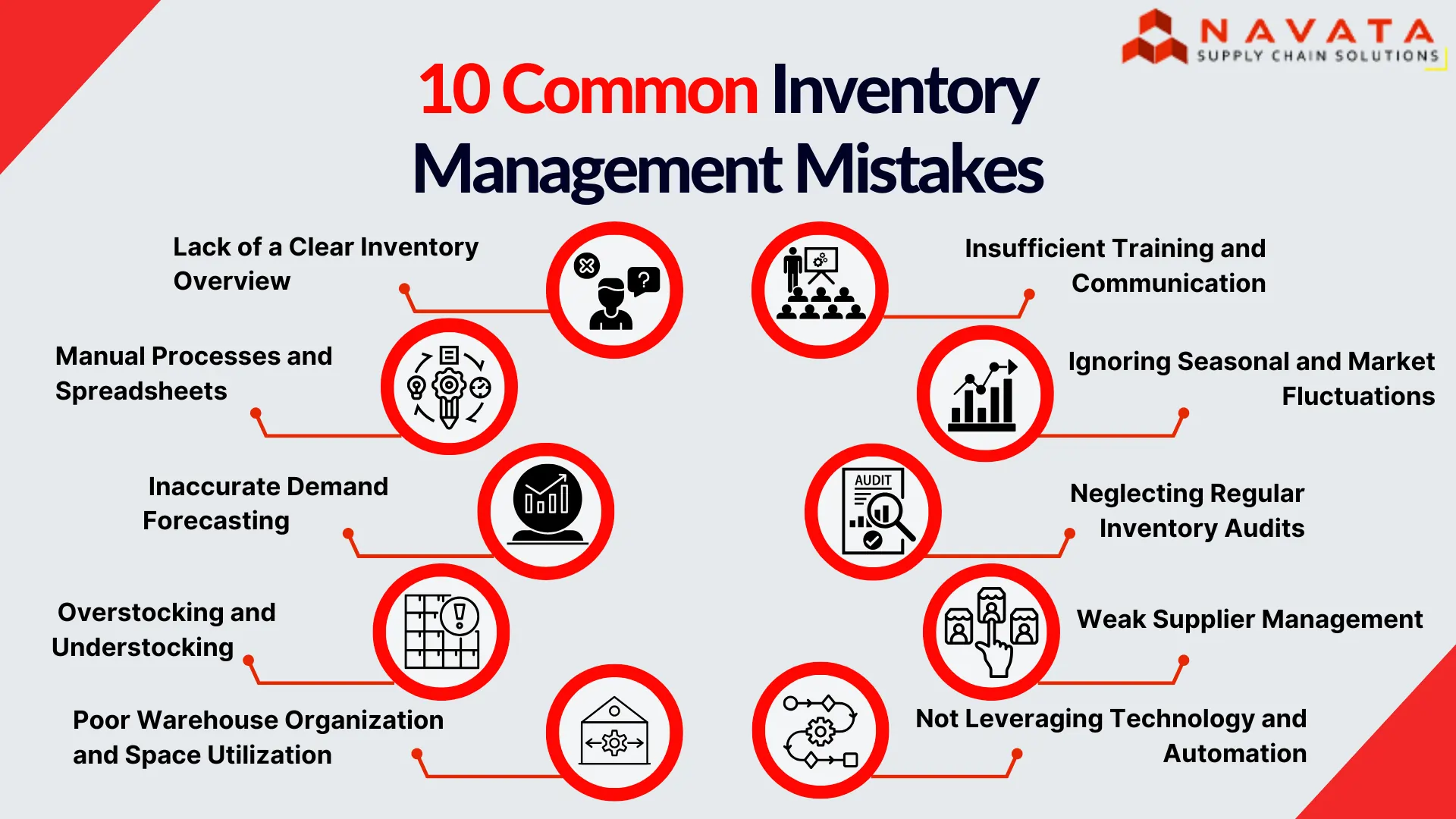Common Inventory Management Mistakes and How to Avoid Them
Cost of Poor Inventory Management
Poor inventory management can hurt a business in many ways. Running out of stock can lead to lost sales and unhappy customers, while holding too much inventory increases storage costs and risks goods becoming outdated. It also affects customer experience—delays, wrong items, and unavailable products reduce trust and loyalty.
Cash flow suffers when money is stuck in extra stock or spent on urgent orders. There’s also a higher chance of theft and costly returns. These issues can lead to financial losses and damage customer relationships. Good inventory management is essential to keep operations smooth and protect business growth.
Many businesses, while striving for success, often fall into inventory mistakes. Recognizing these mistakes is the first step towards implementing effective solutions and optimizing inventory processes.
This blog post will delve into the most common inventory management mistakes that businesses encounter and provide actionable solutions to help them navigate these challenges effectively.
Let’s Dive in!

You May Also Like to Read: E-commerce Inventory Management: Challenges, Control & Solutions
1. Lack of a Clear Inventory Overview
One of the most fundamental errors businesses make is the failure to maintain a real-time, comprehensive view of their inventory levels across all locations and sales channels. This issue is often worse by balancing multiple inventory numbers across various e-commerce platforms, physical stores, and warehouses without a synchronized system. Without knowing exactly what is in stock, where it is located, and what is allocated, businesses operate in the dark, leading to inefficiencies and errors.
Solution
Implementing a centralized inventory tracking system is crucial for providing real-time visibility into stock levels. To avoid overselling, it is beneficial to separate “On Hand” inventory (what is physically on the shelves) from “Allocated” inventory (what has been ordered by customers but not yet shipped). Cloud-based inventory management software offers the advantage of accessibility from anywhere and provides real-time updates, ensuring everyone has the most current information
2. Manual Processes and Spreadsheets
Many businesses still depend heavily on manual inventory tracking methods such as spreadsheets or even pen-and-paper systems. While these methods might seem sufficient in the very early stages of a business, they are inherently limited and prone to inaccuracies.
Manual data entry and calculations significantly increase the risk of human error, leading to discrepancies between physical stock and recorded inventory. Moreover, these processes are often time-consuming, diverting valuable resources away from other critical business activities and impacting overall efficiency. This is a significant drawback in order to achieve objectives of inventory management.
Solution
Investing in dedicated softwares is a significant step towards improving accuracy and efficiency. Features like barcode scanning automate data entry, eliminating the need for manual typing and reducing the likelihood of errors. Automated updates to inventory levels in real-time ensure that the system always reflects the current stock, providing a reliable overview for decision-making.
While there is an initial cost associated with implementing such software, the automation it offers saves considerable time and minimizes costly errors related to manual data handling and inaccurate tracking. These savings in time and resources, combined with improved inventory accuracy and a reduction in stockouts or overstocking, ultimately lead to increased operational efficiency and enhanced profitability.
3. Inaccurate Demand Forecasting
A critical aspect of effective inventory management is the ability to accurately predict future customer demand. Poor demand forecasting is a common mistake that leads to the dual problems of overstocking and understocking. Many businesses fail to adequately account for seasonal fluctuations in demand, emerging market trends, or the impact of promotional activities. This lack of foresight results in either insufficient inventory to meet customer needs during peak periods or an excess of unsold goods during slower times, hindering efficient inventory management.
Solution
To improve demand forecasting, businesses should leverage historical sales data, analyze current market trends, and utilize available forecasting tools. Analyzing past sales data can reveal recurring patterns and trends, providing valuable insights into when specific products are in high demand. Inventory management software often includes features that can assist with this analysis and generate demand forecasts.
Furthermore, a collaborative forecasting process involving input from sales, marketing, and customer service teams can provide a more comprehensive and accurate picture of anticipated demand. Basing inventory orders on intuition or simply repeating previous orders without a thorough analysis of sales data and market dynamics can lead to significant inaccuracies in inventory management.
Streamline Inventory, Maximize Profits Today!
4. Overstocking and Understocking
As highlighted by the issue of inaccurate forecasting, both overstocking and understocking represent significant problems for businesses in inventory management. Overstocking ties up precious cash flow in unsold inventory and leads to increased costs associated with storage, insurance, and potential obsolescence. Conversely, understocking results in lost sales opportunities, dissatisfied customers who may turn to competitors, and potential damage to the business’s reputation.
Solution
The key to avoiding these extremes lies in setting optimal stock levels based on accurate demand forecasting and a clear understanding of supplier lead times, which are crucial for effective inventory management. Implementing safety stock levels, which are extra units of popular items held in reserve, can help buffer against unexpected surges in demand or delays in the supply chain.
Calculating and diligently utilizing reorder points ensures that inventory is replenished in a timely manner, preventing stockouts without leading to excessive stockpiling. For certain business models, adopting a Just-in-Time (JIT) inventory system, where goods are received only as they are needed, can minimize holding costs and reduce waste, contributing to lean inventory management.
Know More About Just-in-Time (JIT) inventory system
5. Poor Warehouse Organization and Space Utilization
The physical organization of a warehouse or storage space plays a vital role in efficient inventory management. A disorganized warehouse can lead to significant inefficiencies, wasted space, and considerable difficulty in locating specific items when needed. This disarray directly impacts picking times for order fulfillment and increases the likelihood of errors in the items selected, hindering smooth inventory management.
Solution
Optimizing the warehouse layout to ensure a logical and efficient flow of goods is essential for effective inventory management. Implementing a clear and consistent labeling and signage system for all products and storage locations makes it easier for staff to quickly identify and locate the necessary items. Utilizing a warehouse management system (WMS) can further streamline storage and retrieval processes, providing better control and visibility over inventory within the warehouse.
For businesses with limited space, considering storage solutions like mobile pallet racking can significantly improve space utilization. Applying the ABC analysis method to strategically place high-demand, fast-moving items in easily accessible locations can also reduce picking times and improve overall efficiency in inventory management.
6. Insufficient Training and Communication
The effectiveness of any inventory management system relies heavily on the people who operate it. Insufficient training of staff involved in inventory management can lead to numerous errors in tasks such as counting stock, handling inventory, and using inventory management software. Furthermore, a lack of clear communication between the inventory team and other departments, particularly sales and purchasing, can result in inconsistency and inefficiencies in the overall inventory management process.
Solution
Providing comprehensive and ongoing training to all employees who handle inventory is crucial for accurate inventory management. This training should cover best practices for inventory handling, the proper use of any inventory management systems in place, and the importance of accuracy in all inventory-related tasks.
Establishing clear and well-defined communication channels and protocols between different departments is equally important for seamless inventory management. Encouraging a culture of transparency and open communication regarding inventory levels, potential issues, and upcoming needs can foster better collaboration and proactive problem-solving.
7. Ignoring Seasonal and Market Fluctuations
Failing to effectively plan for predictable shifts in customer demand due to seasonal changes, promotional events, or broader market trends is a common oversight among businesses in inventory management. This can lead to being caught off guard during peak seasons with insufficient stock to meet demand or being left with an excess of inventory during off-seasons, incurring unnecessary holding costs. This lack of foresight negatively impacts effective inventory management
Solution
Businesses should analyze historical sales data to identify recurring seasonal patterns and trends in demand for their products to improve inventory management. Based on these insights, they should proactively adjust their inventory levels in anticipation of these fluctuations, ensuring they have enough stock to meet increased demand and avoiding overstocking during slower periods.
It is also crucial to plan inventory levels in advance for any planned promotional events or upcoming product launches to ensure sufficient stock is available. Staying informed about relevant industry news and broader market trends that could potentially impact supply and demand for their products is another proactive step businesses should take for better inventory management.
8. Neglecting Regular Inventory Audits
Maintaining accurate inventory records is paramount for effective inventory management, and neglecting regular inventory audits is a significant mistake that many businesses make. Infrequent or even the complete absence of inventory audits leads to a gradual divergence between the recorded stock levels in the system and the actual physical inventory on hand, resulting in inaccurate stock counts and discrepancies.
Solution
Implementing a consistent schedule for conducting inventory audits is essential for maintaining accuracy in inventory management. This should include both regular cycle counts, where a small portion of the inventory is counted frequently, and periodic full physical inventory counts to verify the accuracy of all stock.
Training staff on the correct procedures for conducting audits and ensuring accountability for the accuracy of the counts is also important. Finally, it is crucial to analyze the findings of these audits to identify the underlying causes of any discrepancies and implement corrective actions to prevent similar errors from occurring in the future, improving the overall inventory management process.
9. Weak Supplier Management
The relationships that businesses cultivate with their suppliers have a direct impact on their inventory management effectiveness. Poor supplier relationship management can lead to a host of problems, including unreliable delivery schedules, inconsistencies in product quality, and disruptions throughout the supply chain. Effectively managing lead times and maintaining open lines of communication with suppliers are critical aspects that are often overlooked in inventory management
Solution
Businesses should focus on building strong, collaborative relationships with their key suppliers for better inventory management. This involves establishing clear communication channels and setting mutual expectations regarding reporting, delivery schedules, and product quality. Regularly monitoring supplier performance against agreed-upon metrics and holding them accountable for any shortcomings is also essential.
To mitigate the risk of disruptions from a single supplier, businesses should consider diversifying their supplier base. In some cases, exploring Vendor Managed Inventory (VMI) arrangements, where the supplier takes on the responsibility of monitoring and replenishing inventory levels, can be a beneficial strategy for efficient inventory management.
10. Not Leveraging Technology and Automation
In today’s rapidly evolving business landscape, failing to adopt modern inventory management technologies and embrace automation can significantly hinder a business’s competitiveness. Inventory management software offers a wide range of benefits, including automating routine tasks, improving the accuracy of inventory data, and providing real-time insights into stock levels and trends. The use of barcode scanning and RFID (Radio Frequency Identification) technology can significantly enhance the efficiency and accuracy of tracking inventory as it moves through the supply chain and within the warehouse.
Solution
Integrating inventory management systems with other essential business tools, such as accounting software and e-commerce platforms, creates a seamless flow of data and improves overall operational efficiency. Some businesses might hesitate to adopt new technologies due to concerns about the initial costs or a lack of complete understanding regarding the potential return on investment.
However, while there is an financial outlay associated with implementing inventory management software, the long-term advantages of automation, real-time visibility into inventory data, and a significant reduction in errors far outweigh the initial investment.

Key Takeaways
Avoiding common inventory management mistakes is crucial for businesses aiming for efficiency and profitability. Here’s a checklist of actionable steps:
- Gain a Clear Overview: Implement a centralized system for real-time inventory visibility across all channels and locations.
- Embrace Technology: Invest in inventory management software with features like barcode scanning and automated updates to replace manual processes.
- Forecast Accurately: Utilize historical data, market trends, and forecasting tools for better demand prediction in inventory management.
- Balance Stock Levels: Set optimal stock levels with safety stock and reorder points to avoid both overstocking and understocking in your inventory management.
- Organize Your Warehouse: Optimize layout, implement clear labeling, and consider a WMS for efficient storage and retrieval as part of your inventory management strategy.
- Train Your Team: Provide comprehensive and ongoing training on inventory procedures and systems.
- Plan for Fluctuations: Analyze historical data and market trends to proactively adjust inventory for seasonal and market changes.
- Audit Regularly: Schedule and conduct frequent inventory audits, including cycle counts, to maintain accuracy in your inventory management.
- Manage Suppliers Effectively: Build strong relationships, communicate clearly, and monitor supplier performance for a smoother inventory management process.
- Automate Where Possible: Leverage technology to automate tasks and gain real-time insights for better decision-making in inventory management.
Thinking ahead and managing your stock well isn’t just something you do in the office; it’s a really important part of how your whole business succeeds and grows steadily. If businesses understand and avoid the common mistakes people make when managing their stock, they can find many ways to work better, save money, and make their customers much happier.
Taking the first steps to improve how you handle your stock, whether it’s getting new technology, making your current ways of working better, or training your staff, will help your business work much better and be successful in the long run. If you manage your stock well, your business will do great in today’s competitive world.
Thanks For Reading: 10 Common Inventory Management Mistakes and How to Avoid Them
Powered By 360Presence

